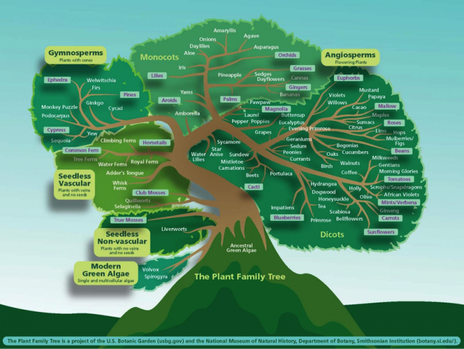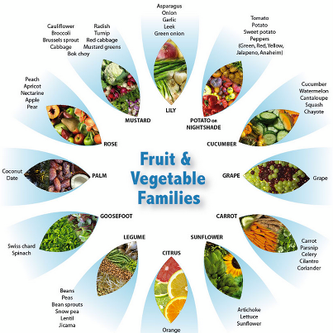Plant Families
How exactly are plants related?

Just like animals, all plant life we see today evolved from a single simple organism (unless you live in Kansas). Throughout the years various mutations created branches off the family tree providing us with the incredible diversity we see today. Some plants are so unique they belong to a family of their own while other branches contain lots of "cousins". As a gardener it is helpful to know what plants are related because they generally need similar nutrients and growing conditions to thrive,
Does it really matter?
Understanding what family your plant belongs to is important for crop rotation purposes. You'll do better by not planting the tomatoes in the same spot 2 years in a row, but if you really want to maximize the benefits of rotating the plants in your garden, you want to avoid planting anything from the same family in that spot as well. Click here for more information on crop rotation and how plant families fit in
Vegetable Family Index

This is actually a little trickier than it should be. The reason is, depending on where you look people will classify the groups using the scientific name, a more common name, or an example of one of the plants in the family. Some places over-simplify it while others break up families into 2 or 3 sub-families. We've done our best to compile a comprehensive list and include all the possible names you might come across, but the good news is we're not going to test you on this and you really don't need to know what anyone calls anything. All you need to do is avoid planting 2 items from the same family in the same spot in back to back years. Some of the related plants are obvious while others may surprise you.
Asteraceae/Compositae/Daisy family – Asteraceae (Compositae)
- Lettuce
- Chicory/Endive
- Jerusalem Artichoke
- Globe Artichoke
- Dandelion
- Sunflower
- Safflower
- Tarragon
- Artemisia
- Salsify/Scorzonera
- Chamomile
- (Marigolds and Chrysanthemums are also in this family)
- Onion
- Shallot
- Garlic
- Chives
- Leek
- Broccoli
- Brussel Sprouts
- Cauliflower
- Cabbage
- Collard Greens
- Horseradish
- Mustard
- Kale
- Kohlrabi
- Radish
- Cress
- Rutabaga
- Bok choy
- Chinese Cabbage
- Watercress
- Turnip
- Wasabi
- Cucumber
- Honeydew melon
- Cantaloupe/Muskmelon
- Watermelon
- Pumpkin
- Squash/Marrow
- Zucchini/Courgette
- Luffa
- Eggplant (Aubergine)
- Pepper
- Potato
- Tomato, tomatillo
- Paprika
- Chile pepper
- Alfalfa
- Lentil
- Peanut
- Bean
- Soybean
- Clover
- Lupin
- Pea
- Carrot
- Celery
- Fennel (always plant ALONE)
- Dill (don’t plant with carrots or tomatoes)
- Parsley
- Parsnip
- Cumin
- Coriander/Cilantro
- Caraway
- Queen Anne’s Lace
- Beetroot
- Quinoa
- Spinach
- Goosefoot
- Swiss Chard (Spinach Beet)
- Amaranth
- Sugar beet
- (also Lamb’s Quarters)
- Corn/Maize (grow after carrots)
- Oats
- Rice
- Rye
- Sorghum
- Barley
- Wheat
- Mallet
- Sugarcane
- Lamb’s Lettuce/Corn Salad (Valerianaceae)
- New Zealand Spinach (Aizoaceae)
- Purslane, Portulaca, Miner’s Lettuce (Portulacaceae)
- Rhubarb, Buckwheat (Polgonaceae)
- Okra (Mallow family, Malvaceae; cacao is also in this family)
Sources
Original list compiled by Meredith O'Riley - http://www.greatstems.com/2009/09/vegetable-families.html